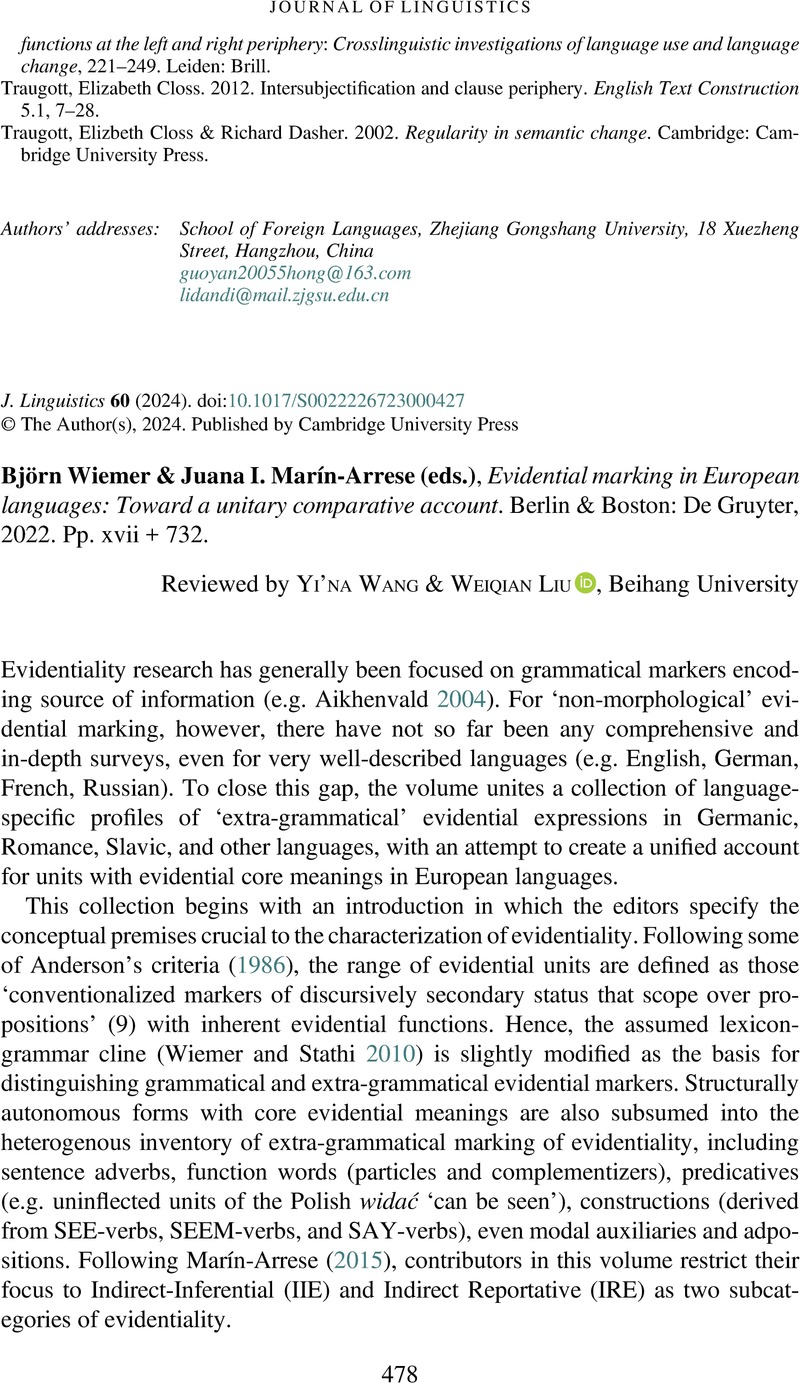No CrossRef data available.
Article contents
Björn Wiemer & Juana I. Marín-Arrese (eds.), Evidential marking in European languages: Toward a unitary comparative account. Berlin & Boston: De Gruyter, 2022. Pp. xvii + 732.
Review products
Björn Wiemer & Juana I. Marín-Arrese (eds.), Evidential marking in European languages: Toward a unitary comparative account. Berlin & Boston: De Gruyter, 2022. Pp. xvii + 732.
Published online by Cambridge University Press: 08 February 2024
Abstract
An abstract is not available for this content so a preview has been provided. Please use the Get access link above for information on how to access this content.

- Type
- Book Review
- Information
- Copyright
- © The Author(s), 2024. Published by Cambridge University Press
References
REFERENCES
Aikhenvald, Alexandra Y. 2004. Evidentiality. Oxford: Oxford University Press.CrossRefGoogle Scholar
Anderson, Lloyd B. 1986. Evidentials, paths of change, and mental maps: Typologically regular asymmetries. In Chafe, Wallace L. & Nichols, Johanna (eds.), Evidentiality: The linguistic coding of epistemology, 273–312. Norwood, NJ: Ablex Publishing.Google Scholar
Ad, Foolen, de Hoop, Helen & Mulder, Gijs. 2018. Evidence for evidentiality. Amsterdam & Philadelphia: John Benjamins.Google Scholar
Langacker, R. W. 2017. Evidentiality in cognitive grammar. In Marín-Arrese, Juana Isabel, Haßler, Gerda & Carretero, Marta (eds.), Evidentiality revisited. Cognitive grammar, functional and discourse-pragmatic perspectives, 13–55. Amsterdam & Philadelphia: John Benjamins.CrossRefGoogle Scholar
Weiqian, Liu & Wang, Yi’na. 2020. Book review: Ad Foolen et al. (2018), Evidence for evidentiality, John Benjamins. Journal of Pragmatics 170, 206–209.Google Scholar
Marín-Arrese, Juana I. 2015. Epistemicity and stance: A cross-linguistic study of epistemic stance strategies in journalistic discourse in English and Spanish. A cross-linguistic perspective. Discourse Studies 17.2, 210–225.CrossRefGoogle Scholar
Mortelmans, Tanja. 2017. Seem-type verbs in Dutch and German: lijken, schijnen & scheinen. In Marín-Arrese, Juana Isabel, Haßler, Gerda & Carretero, Marta (eds.), Evidentiality revisited. Cognitive grammar, functional and discourse-pragmatic perspectives, 123–148. Amsterdam & Philadelphia: John Benjamins.CrossRefGoogle Scholar
Vliegen, Maurice. 2011. Evidentiality. Dutch seem and appear verbs blijken, lijken, schijnen. Linguistics in the Netherlands 2011, 125–137.CrossRefGoogle Scholar
Wiemer, Björn & Stathi, Katerina. 2010. Introduction. The database of evidential markers in European languages. A bird’s eye view of the conception of the database (the template and problems hidden beneath it). STUF/Language Typology and Universals 63.4, 275–285.CrossRefGoogle Scholar



